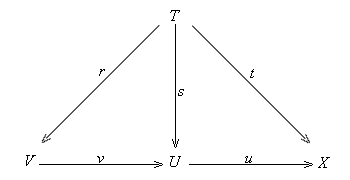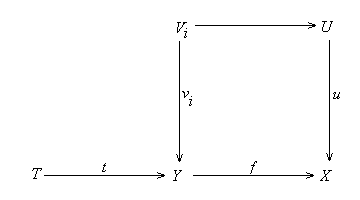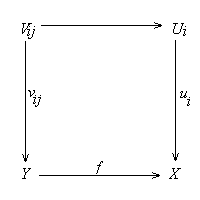Suppose A is a category with a strict initial object 0. Consider a functor G from A to the category of locales.
Definition 2.5.1. A mono u:
U --> X in A and its image ![]() (u):
(u): ![]() (U)
-->
(U)
--> ![]() (X) is called open
effective if the following conditions are satisfied:
(X) is called open
effective if the following conditions are satisfied:
(a) ![]() (u) is an
open embedding of locales.
(u) is an
open embedding of locales.
(b) If t: T --> X is a map in A
such that ![]() (t) factors
through
(t) factors
through ![]() (u) then
t factors through u (uniquely).
(u) then
t factors through u (uniquely).
If u is open effective then u or U is called an open
effective subobject of X, and ![]() (u)
or
(u)
or ![]() (U) is an open
effective sublocale of
(U) is an open
effective sublocale of ![]() (X).
(X).
Definition 2.5.2. A framed
topology on A is a functor ![]() from A to the category of locales, satisfying
the following conditions:
from A to the category of locales, satisfying
the following conditions:
(a) An object X is initial iff ![]() (X)
is initial.
(X)
is initial.
(b) Any open sublocale of ![]() (X)
is a join of open effective sublocales of
(X)
is a join of open effective sublocales of ![]() (X).
(X).
A framed topology ![]() is spatial
if for any object X the locale
is spatial
if for any object X the locale ![]() (X)
is spatial.
(X)
is spatial.
Example 2.5.2.1. (a) The identity
functor on the category of locales is a framed topology.
(b) The functor on the category of topological spaces sending each
topological space to the locale of its open sets is a spatial framed topology.
Suppose ![]() is a framed
topology on A. If {Ui} is
a set of open effective subobjects of X such that
is a framed
topology on A. If {Ui} is
a set of open effective subobjects of X such that ![]() (X)
is the join of {
(X)
is the join of {![]() (Ui)},
then we say that {Ui} (resp. {
(Ui)},
then we say that {Ui} (resp. {![]() (Ui)})
is an open
effective cover on X (resp.
(Ui)})
is an open
effective cover on X (resp. ![]() (X)).
(X)).
Proposition 2.5.3. Suppose u:
U --> X is an open effective mono and t: T --> X is a
map.
(a) t is disjoint with u iff ![]() (t)
is disjoint with
(t)
is disjoint with ![]() (u)
(i.e.
(u)
(i.e. ![]() (t)-1(
(t)-1(![]() (U)
= 0).
(U)
= 0).
(b) If u is a normal mono then t is dominated by u
iff ![]() (t) factors
through
(t) factors
through ![]() (u).
(u).
Proof. (a) If s: S --> X is a map factors through
both u and t then ![]() (s):
(s): ![]() (S)
-->
(S)
--> ![]() (X) factors
through
(X) factors
through ![]() (t)-1(
(t)-1(![]() (U)),
so s must be initial if
(U)),
so s must be initial if ![]() (t)-1(
(t)-1(![]() (U))
= 0 by (2.5.2.a). Conversely if the open sublocale
(U))
= 0 by (2.5.2.a). Conversely if the open sublocale ![]() (t)-1(
(t)-1(![]() (U)
(U) ![]() 0 then it is a join of non-initial open effective sublocales {vi:
Vi --> T} by (2.5.2.b), and each tvi
factors through both u and t. Thus t is not disjoint
with u.
0 then it is a join of non-initial open effective sublocales {vi:
Vi --> T} by (2.5.2.b), and each tvi
factors through both u and t. Thus t is not disjoint
with u.
(b) If u is normal then t is dominated by u iff
t factors through u, which is equivalent to that ![]() (t)
factors through
(t)
factors through ![]() (u)
by (2.5.1.b) as u is effective.
(u)
by (2.5.1.b) as u is effective.
Proposition 2.5.4. Suppose {ui:
Ui --> X} is a set of open effective monos and t:
T --> X is a map.
(a) t is disjoint with each ui iff ![]() (t)
is disjoint with the join of
(t)
is disjoint with the join of ![]() (ui).
(ui).
(b) t is dominated by {ui: Ui
--> X} if ![]() (t)
factors through the join of
(t)
factors through the join of ![]() (Ui).
(Ui).
Proof. (a) Assume t is disjoint with each ui.
Then ![]() (t)-1(
(t)-1(![]() (Ui))
= 0 for each Ui by (2.5.3.a).
Thus
(Ui))
= 0 for each Ui by (2.5.3.a).
Thus
(b) Suppose
Denote by D(![]() )
the class of open effective monos for a framed topology
)
the class of open effective monos for a framed topology ![]() .
.
Proposition 2.5.5. D(![]() )
is a submonic divisor.
)
is a submonic divisor.
Proof. Clearly the isomorphisms are open effective. The initial
maps are open effective as a consequence of (2.5.2.a).
We prove that D(![]() )
is closed under composition. Suppose u: U --> X and v:
V --> U are two open effective monos. Then
)
is closed under composition. Suppose u: U --> X and v:
V --> U are two open effective monos. Then ![]() (uv)
=
(uv)
= ![]() (u)
(u)![]() (v)
as a composite of open embeddings of locales is an open embedding. If t:
T --> X is a map in A such that
(v)
as a composite of open embeddings of locales is an open embedding. If t:
T --> X is a map in A such that ![]() (t)
factors through
(t)
factors through ![]() (u)
(u)![]() (v),
then t factors through u uniquely in a map s: T
--> U because u is open effective and
(v),
then t factors through u uniquely in a map s: T
--> U because u is open effective and ![]() (t)
factors through
(t)
factors through ![]() (u).
It follows that s factors through v in a map r:
T --> V as v is open effective and
(u).
It follows that s factors through v in a map r:
T --> V as v is open effective and ![]() (s)
factors through
(s)
factors through ![]() (v).
This shows that t factors through uv. Thus uv is open
effective.
(v).
This shows that t factors through uv. Thus uv is open
effective.


The monic divisor D(![]() )
is called the open
divisor of
)
is called the open
divisor of ![]() .
.
Proposition 2.5.6. Any open effective cover is a unipotent cover.
Proof. Suppose {Ui} is an open effective cover
on X. Then ![]() (X)
is the join of {
(X)
is the join of {![]() (Ui)}.
Applying (2.5.4.b) we see that the identity map X
® X is dominated by {ui:
Ui ® X}. Thus {ui}
is a unipotent cover on X.
(Ui)}.
Applying (2.5.4.b) we see that the identity map X
® X is dominated by {ui:
Ui ® X}. Thus {ui}
is a unipotent cover on X.
Proposition 2.5.7. The collection T(![]() )
of open effective covers is a unipotent Grothendieck topology on A.
)
of open effective covers is a unipotent Grothendieck topology on A.
Proof. We verify the three conditions of a Grothendieck topology
for T(![]() ) (cf. (2.3.4)).
) (cf. (2.3.4)).
(a) Clearly any isomorphism is an open cover and the empty set is an
open cover only on 0 .
(b) Suppose {ui: Ui --> X} is an
open cover on X and f: Y --> X is any map. Then each ![]() (f)-1(
(f)-1(![]() (Ui)
is a join of open effective sublocales {
(Ui)
is a join of open effective sublocales {![]() (vij):
(vij): ![]() (Vij)
®
(Vij)
® ![]() (Y)}.
Since
(Y)}.
Since ![]() (Y) is the
join of {
(Y) is the
join of {![]() (f)-1(
(f)-1(![]() (ui)},
it is the join of {
(ui)},
it is the join of {![]() (vij)}.
Thus {vij: Vij --> Y} is an open effective
cover on Y such that for each ij, fvij
factors through ui.
(vij)}.
Thus {vij: Vij --> Y} is an open effective
cover on Y such that for each ij, fvij
factors through ui.

These together with (2.5.6) show that T(
Remark 2.5.8. If A
has pullbacks then one can show that the open divisor D(![]() )
of any framed topology
)
of any framed topology ![]() is a stable divisor (see [L2]).
is a stable divisor (see [L2]).
Suppose ![]() is a framed
topology on A. A sieve U on an object
X is called open if it is the pullback of an open embedding
v: V -->
is a framed
topology on A. A sieve U on an object
X is called open if it is the pullback of an open embedding
v: V --> ![]() (X)
of locales (i.e., a map s is in U iff
(X)
of locales (i.e., a map s is in U iff ![]() (s)
factors through v); an open sieve is effective
if it is generated by an open effective mono. The set of open sieves on
X is a locale isomorphic to
(s)
factors through v); an open sieve is effective
if it is generated by an open effective mono. The set of open sieves on
X is a locale isomorphic to ![]() (X)
naturally. Thus a framed topology can be defined intrinsically as a function
which assigns to each object a locale of sieves (cf. [Luo
1995b].
(X)
naturally. Thus a framed topology can be defined intrinsically as a function
which assigns to each object a locale of sieves (cf. [Luo
1995b].